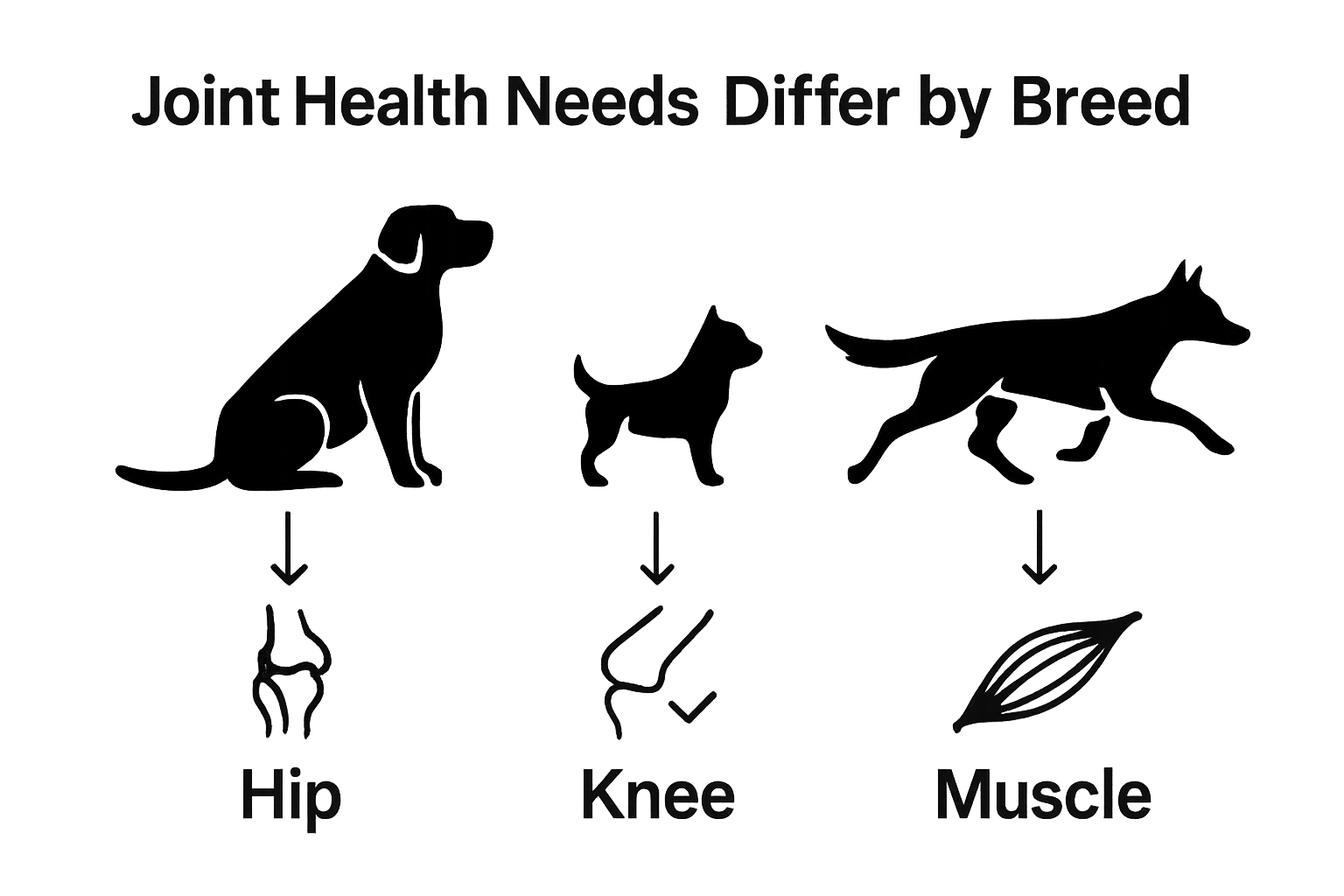
Understanding Dog Food for Joint Health: A Comprehensive Guide
Share
Dog owners often worry when their pets slow down or struggle with stairs because joint problems affect almost half of older dogs. It sounds like the solution is all about medication and rest. But research shows that the right dog food can noticeably slow joint damage and improve movement. The ingredients on your dog’s food label might make more difference than you ever guessed.
Table of Contents
- What Is Dog Food For Joint Health And Why It Matters?
- The Role Of Nutrients In Joint Health
- Understanding Grain-Free Diets And Their Benefits
- How Breed And Life Stage Influence Joint Health Needs
- Choosing Premium, Vet-Approved Options For Optimal Care
Quick Summary
| Takeaway | Explanation |
|---|---|
| Prioritise joint health nutrition | Focus on foods that support cartilage integrity and reduce inflammation, especially for aging dogs or those with joint issues. |
| Include Omega-3 fatty acids | These natural anti-inflammatory compounds help reduce joint discomfort and maintain mobility in dogs. |
| Choose grain-free options when needed | Grain-free diets can minimize allergens and support better digestion and nutrient absorption for dogs prone to sensitivities. |
| Tailor diets to breed and life stage | Different breeds and ages have specific nutritional needs for optimal joint health; adjust diets accordingly. |
| Select high-quality, vet-approved food | Ensure the dog food is formulated with premium ingredients and targeted nutrients for effective joint health support. |
What is Dog Food for Joint Health and Why It Matters?
Joint health represents a critical aspect of a dog’s overall wellness, particularly as they age or experience breed-specific mobility challenges. Dog food for joint health is a specialized nutritional approach designed to support and maintain optimal joint function, reduce inflammation, and mitigate potential discomfort associated with conditions like arthritis, hip dysplasia, and general wear and tear.
The Science Behind Joint-Supportive Nutrition
Joint health in dogs fundamentally depends on maintaining cartilage integrity, reducing inflammatory responses, and supporting connective tissue strength. Our guide on holistic dog nutrition explains that targeted nutrition plays a pivotal role in this process. The most effective joint health dog foods incorporate specific nutrients that directly impact musculoskeletal wellness:
- Omega-3 Fatty Acids: Natural anti-inflammatory compounds that reduce joint inflammation
- Glucosamine and Chondroitin: Essential compounds for cartilage repair and maintenance
- Antioxidants: Support cellular health and reduce oxidative stress
According to veterinary research from Cornell University, proper nutritional intervention can significantly slow joint degradation and improve mobility in dogs experiencing early stages of joint complications.
Why Joint Health Nutrition Matters
For dog owners, understanding joint health nutrition goes beyond simple feeding. It represents a proactive approach to preventing potential mobility issues and maintaining quality of life. Dogs experiencing joint stress may show subtle signs like decreased activity, reluctance to climb stairs, or visible discomfort during movement.
Our specially formulated kibble contains freshly prepared meat, gently cooked at 82°C to preserve nutrients, and includes prebiotics MOS and FOS to support overall digestive and joint health. By choosing targeted nutritional solutions, pet owners can provide comprehensive support for their canine companions’ long-term wellness and mobility.
To clarify the function of key nutrients for canine joint support, the following table summarises each nutrient and its role in joint health.
| Nutrient | Role in Joint Health |
|---|---|
| Glucosamine | Stimulates cartilage production and supports lubrication |
| Chondroitin | Enhances cartilage elasticity and reduces inflammation |
| Omega-3 Fatty Acids | Provides anti-inflammatory effects, supports mobility |
| MSM (Methylsulfonylmethane) | Supports connective tissue repair and reduces oxidative stress |
| Antioxidants | Maintains cellular health and reduces oxidative damage |
The Role of Nutrients in Joint Health
Nutrients play a fundamental role in maintaining and supporting canine joint health, serving as critical building blocks for cartilage repair, inflammation management, and overall musculoskeletal wellness. Understanding the intricate relationship between specific nutritional components and joint function helps pet owners make informed dietary choices.
Essential Nutrients for Joint Support
Certain nutrients have demonstrated remarkable capabilities in promoting joint health and mitigating degenerative processes. Research from the Veterinary College of Nutrition highlights the significance of targeted nutritional interventions for canine joint maintenance:
- Glucosamine: A natural compound that stimulates cartilage production and supports joint lubrication
- Chondroitin: Works synergistically with glucosamine to enhance cartilage elasticity and reduce inflammation
- Methylsulfonylmethane (MSM): Supports connective tissue repair and reduces oxidative stress
These nutrients function as molecular architects, helping reconstruct and protect joint infrastructure by providing essential components for cellular regeneration and reducing inflammatory responses.
Omega-3 Fatty Acids: Nature’s Joint Protectors
Omega-3 fatty acids, particularly EPA and DHA, emerge as powerful allies in joint health management. These essential fatty acids possess potent anti-inflammatory properties that can significantly mitigate joint discomfort and slow degenerative processes. By interrupting inflammatory pathways, omega-3s help maintain joint mobility and reduce the progression of conditions like osteoarthritis.
Our freshly prepared kibble, gently cooked at 82°C, preserves these critical nutrients while providing a balanced approach to joint support. By incorporating human-grade ingredients and prebiotic components like MOS and FOS, we ensure comprehensive nutritional support that extends beyond basic joint maintenance to overall canine wellness.

Understanding Grain-Free Diets and Their Benefits
Grain-free diets have emerged as a significant nutritional strategy for dogs, offering potential health advantages beyond traditional grain-inclusive formulations. This approach focuses on eliminating wheat, corn, rice, and other grain sources, replacing them with nutrient-dense alternative ingredients that support canine wellness.
The Nutritional Philosophy Behind Grain-Free Feeding
Our comprehensive guide on grain-free diets explains that grain-free nutrition mimics the ancestral dietary patterns of dogs’ wild predecessors. Modern canines, while domesticated, still retain genetic predispositions that favour protein-rich, grain-alternative nutrition. The primary objectives of grain-free diets include:
- Reduced Inflammatory Response: Minimising potential allergens and inflammatory triggers
- Enhanced Protein Absorption: Prioritising high-quality animal protein sources
- Improved Digestive Efficiency: Supporting more natural metabolic processing
According to veterinary nutritional research, grain-free diets can significantly impact dogs with specific health sensitivities, particularly those experiencing digestive complications or food-related allergies.
Potential Benefits for Joint and Metabolic Health
For dogs experiencing joint challenges, grain-free nutrition offers additional advantages. By reducing inflammatory ingredients and focusing on high-quality proteins and nutrient-dense alternatives like sweet potato, pumpkin, and legumes, these diets can support overall metabolic function. Our freshly prepared kibble, gently cooked at 82°C, preserves critical nutrients while providing a balanced approach that includes human-grade ingredients and prebiotic components like MOS and FOS, ensuring comprehensive nutritional support tailored to individual canine needs.
How Breed and Life Stage Influence Joint Health Needs
Canine joint health is not a one-size-fits-all proposition. Different dog breeds and life stages present unique nutritional requirements that significantly impact joint wellness, mobility, and long-term musculoskeletal health. Understanding these nuanced differences enables pet owners to provide targeted nutritional support.
The following table compares joint health considerations and needs across various dog breeds and life stages, helping owners select tailored nutrition for their companions.
| Category | Common Risks/Needs | Nutritional Focus |
|---|---|---|
| Giant Breeds | Hip dysplasia, early joint wear | Enhanced joint protection, controlled growth factors |
| Small Breeds | Patellar luxation, compact joints | Targeted joint support, balanced mineral content |
| Working Breeds | High activity, repetitive impact | Elevated protein, advanced joint support nutrients |
| Puppies | Rapid growth, developing joints | Balanced calcium, phosphorus, joint-building nutrients |
| Adults | Maintenance of joint structure | Sustained antioxidant and joint support intake |
| Seniors | Age-related degeneration, stiffness | Increased glucosamine, chondroitin, omega-3 level |
Breed-Specific Joint Considerations
Our comprehensive guide to life stage nutrition highlights the critical variations in joint health needs across different breeds.
 Large breed dogs, such as German Shepherds and Labrador Retrievers, are particularly susceptible to joint challenges due to their rapid growth and increased body weight:
Large breed dogs, such as German Shepherds and Labrador Retrievers, are particularly susceptible to joint challenges due to their rapid growth and increased body weight:
- Giant Breeds: Higher risk of hip dysplasia and early joint degradation
- Small Breeds: More prone to patellar luxation and compact joint stress
- Working Breeds: Require enhanced nutritional support for high-intensity activities
According to veterinary orthopedic research, nutritional interventions must be carefully calibrated to match each breed’s unique physiological characteristics and potential genetic predispositions.
Nutritional Needs Across Life Stages
Joint health nutrition evolves dramatically from puppyhood through senior years. Puppies require balanced nutrients to support proper joint development, while adult dogs need maintenance support, and seniors demand more intensive joint protection. Our freshly prepared kibble, gently cooked at 82°C, provides tailored nutritional profiles that adapt to these changing requirements, incorporating human-grade ingredients and prebiotic components like MOS and FOS to ensure comprehensive joint support throughout a dog’s entire life cycle.
Choosing Premium, Vet-Approved Options for Optimal Care
Selecting the right dog food for joint health requires more than casual consideration. Premium, vet-approved nutrition represents a strategic investment in your canine companion’s long-term wellness, focusing on scientifically formulated solutions that address specific physiological needs.
Criteria for Premium Joint Health Nutrition
Our comprehensive guide on dog food ingredients emphasises the importance of understanding nutritional composition. Premium joint health dog food should demonstrate several critical characteristics:
- High-Quality Protein Sources: Preferably from single, identifiable animal proteins
- Targeted Nutrient Profiles: Specific ratios of glucosamine, chondroitin, and omega-3 fatty acids
- Minimal Processing: Preserving nutritional integrity through gentle cooking techniques
According to veterinary nutritional research, the quality of ingredients directly correlates with the effectiveness of joint health interventions.
Beyond Ingredients: Holistic Veterinary Considerations
Vet-approved nutrition transcends basic ingredient lists. It encompasses comprehensive understanding of individual dog requirements, considering factors like breed predisposition, age-related changes, and existing health conditions. Our freshly prepared kibble, gently cooked at 82°C, represents this holistic approach by incorporating human-grade ingredients, carefully selected prebiotic components like MOS and FOS, and a commitment to supporting canine joint health through scientifically validated nutritional strategies.
Support Your Dog’s Joints with Science-Backed Nutrition
If you are concerned about your dog’s joint health, you already know how important it is to act before discomfort or mobility loss sets in. This comprehensive guide highlighted the impact of key nutrients such as glucosamine, chondroitin, and omega-3s as well as the benefits of grain-free recipes for reducing inflammation and supporting strong joints. Many owners worry about their dogs slowing down or showing reluctance to move. Choosing the right food can make all the difference.
Why settle for uncertainty when premium nutrition is within your reach? Our Dry Dog Food | Grain-Free & Science-Backed Kibble range is crafted for effective, everyday joint support. We offer breed-specific grain-free options, whether your companion is small or large. Explore our Small Breed Grain Free Dog Food | Freshly Prepared & Natural or Grain Free Large Breed ALL solutions for tailored results.

Give your dog premium care with our freshly prepared, gently cooked diets. Visit Ultimate Pet Foods today and discover the right formulation for joint health. Take action now and help your best friend move comfortably every day.
Frequently Asked Questions
What are the key nutrients for supporting joint health in dogs?
Essential nutrients for joint health in dogs include glucosamine, chondroitin, omega-3 fatty acids, and antioxidants. These compounds help maintain cartilage integrity, reduce inflammation, and support connective tissue strength.
How do grain-free diets benefit dogs with joint health issues?
Grain-free diets can reduce inflammatory responses by eliminating potential allergens, focus on high-quality protein sources, and improve digestive efficiency. This nutritional approach can be particularly beneficial for dogs experiencing joint challenges.
How does a dog’s breed affect their joint health needs?
Different breeds have specific joint health considerations; for example, large breeds may be more susceptible to hip dysplasia, while small breeds may face risks from patellar luxation. Understanding these breed-specific requirements is crucial for providing appropriate nutritional support.
What are some signs that my dog may need joint health nutrition?
Signs your dog might benefit from joint health nutrition include decreased activity, reluctance to climb stairs, or visible discomfort during movement. Being proactive in nutrition can help address these issues before they become severe.
Recommended
- How to Choose Dog Food: A Step-by-Step Guide for Healthy Dogs – Ultimate Pet Foods
- Understanding Common Dog Food Ingredients for Healthier Pups – Ultimate Pet Foods
- Understanding Low Fat Dog Food: Key Concepts and Insights – Ultimate Pet Foods
- What Ingredients to Avoid in Dog Food for Healthier Pups – Ultimate Pet Foods
